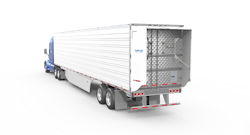Hardware Report: Trailer aerodynamics
For fleets seeking fuel cost savings through improved trailer aerodynamics, side skirts and other devices are now a proven approach. There are also a growing number of options available for streamlining airflow at the rear of trailers.
Introduced recently by Wabco Holdings are the OptiFlow Tail and OptiFlow AutoTail aerodynamics technologies, the first products to result from Wabco’s 2016 acquisition of Laydon Composites Ltd. OptiFlow AutoTail, which the manufacturer says delivers fuel savings of up to 4.3% at highway speeds based on SmartWay test protocols, features automatic deployment and retraction.
Based on speed determined by sensors linked to Wabco trailer ABS, the OptiFlow AutoTail device automatically deploys at 45 mph and retracts at 10 mph. The manufacturer notes automatic retraction enhances safety by ensuring panels are folded when a vehicle is in a loading dock and in other areas.
New from Stemco is TrailerTail Covered, which features side panels that cover the lock rod handles on most trailers, requiring drivers to deploy the fairing in order to open or close the rear doors. TrailerTail Covered is available for the TrailerTail Trident and TrailerTail 4x4 manual deployment systems at no additional cost.
Fleets have the option of using Stemco AutoDeploy, which features a speed sensor that automatically deploys a TrailerTail when the vehicle reaches 35 mph. The manufacturer has also announced the availability of ZeroTouch deployment technology for its TrailerTail product line. As an alternative to its radar-based AutoDeploy technology, ZeroTouch uses the trailer’s existing ABS ECU to reduce installation costs and simplify maintenance.
Available from Wabash National is the AeroFin Tail, which is designed to deploy and retract with swing door operation, requiring no additional interaction from the driver. The manufacturer also offers a slightly larger version in the AeroFin XL Tail model.
Manufacturers note that significant fuel savings from improved trailer aerodynamics are possible when combinations of devices are employed. “Standalone devices yield anywhere from a 1% to an 8.9% improvement in fuel economy,” said Brian Bauman, vice president and general manager at Wabash Composites. “With SmartWay Elite device combinations, however, a fleet can save 9% or more at highway speeds.”
Wabash National offers a variety of trailer aerodynamic devices, including five that are SmartWay approved. In addition to the AeroFin Tail models, there is the DuraPlate AeroSkirt for over-the-road trailers, including LTL and tank applications, and the new lighter weight AeroSkirt CX. As an alternative to conventional side skirts, the Ventix DRS (drag reduction system) utilizes segmented panels mounted to direct airflow under and around the trailer. The newest offering is AeroLink, a nose fairing that reduces drag between the cab and trailer or between tandem trailers.
Trailer side skirts on the market include the Stemco EcoSkirt line in a variety of configurations. Offered by Ridge are the Green Wing and the three-piece FreightWing.
Fleet Engineers offers three side skirt options: AeroSaver, AeroSaver Classic, and the new AeroSaver pup skirt. AeroSaver is available in a variety of configurations, including a one-piece panel to facilitate OEM installation, a two-piece panel for pup trailers, and a three-piece panel to simplify installation for a fleet.
Under new greenhouse gas regulations, tractors and trailers are considered an integral system, meaning trailer aerodynamics will play an increasingly larger role in the coming years.
